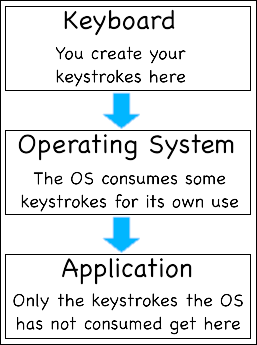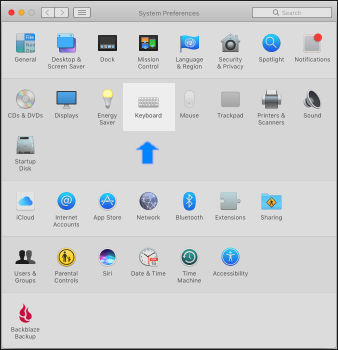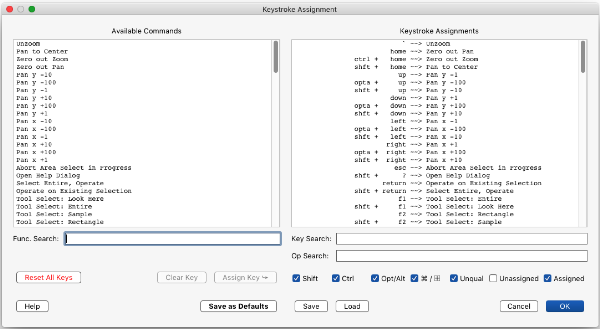§ 29 - Keystroke Assignment Dialog
§ 29.1 - Overview
Depending on which operating system you are using [OS X (MacOS) or Windows 10] and exactly how you have any user-adjustable operating system keyboard preferences configured, some of the assigned-by-default-keystrokes in iToolBox (as detailed here) will not work for you, because the operating system is consuming those keystrokes before they reach iToolBox.
In addition, for Windows 10 users, because OS X (MacOS) uses the ⌘ key to access menus, while Windows 10 uses the control key for the same purpose, some Windows 10 command mappings "collide" with the iToolBox default key command assignments and again, the Windows 10 operating system will consume them and so iToolBox will never receive them.
OS X (MacOS) allows you to choose which keystrokes are used (consumed) by the operating system using the System Keyboard Preferences. However, Windows 10 does not offer up a readily-accessible mechanism to do this, so Windows 10 users are more constrained as to which key combinations may be used within iToolBox.
Finally, even if everything works without any OS-interception of keystrokes immediately upon first use, you may simply prefer different iToolBox keyboard shortcuts than those provided by default.
The Keystroke Assignment dialog is provided to assist you in addressing these issues.
You can assign any available keystroke (meaning, a keystroke that will not be consumed by the operating system thus preventing iToolBox from receiving it) to your choice of in-image-context command, as well as remove iToolBox command assignments from keystrokes, save and load sets of keystroke arrangements, and reset the entire keystroke system to the installation defaults. You can also save a default.kbc file which will be automatically loaded when iToolBox starts, thus providing you with a custom keystroke arrangement for every working session.
§ 29.2 - Dialog Controls
§ 29.2.1 - Available Commands (list)
The Available Commands list presents every command, unless filtered by the Func. Search string, in which case it will list only those commands that contain the search string.
§ 29.2.2 - Func. Search String
This provides a case-insensitive filter for the Available Commands list; if you enter a string into this control, only commands that contain that string will be listed.
§ 29.2.3 - Keystroke Assignments (list)
The Keystroke Assignments list presents keystrokes; when the dialog opens, it only lists keystrokes that are presently assigned commands; this is because the ✓ Assigned checkbox is checked and the ✓ Unassigned checkbox is not. If you uncheck ✓ Assigned and check ✓ Unassigned then only unassigned keystrokes will be listed. If both are checked, then all keystrokes are listed. You can also filter which keystrokes are available with the Key Search and Op Search strings, and choose whether various modifier keys are listed with a set of four related checkboxes.
§ 29.2.4 - Key Search String
This provides one of two case-insensitive filters for the Keystroke Assignments list; if you enter a string into this control, only keystrokes that match that key will be listed.
§ 29.2.5 - Op Search String
This provides one of two case-insensitive filters for the Keystroke Assignments list; if you enter a string into this control, only keystrokes with assigned commands that contain that string will be listed.
§ 29.2.6 - Shift Checkbox
The ✓ Shift checkbox, when checked, causes the Keystroke Assignments list to list those keystrokes that incorporate the shift key.
§ 29.2.7 - Ctrl Checkbox
The ✓ Ctrl checkbox, when checked, causes the Keystroke Assignments list to list those keystrokes that incorporate the control key.
§ 29.2.8 - Opt/alt Checkbox
The ✓ Opt/Alt checkbox, when checked, causes the Keystroke Assignments list to list those keystrokes that incorporate the Opt [OS X (MacOS)] / Alt [Windows 10] key.
§ 29.2.9 - ⌘ / ⊞ checkbox
The ✓ ⌘ / ⊞ checkbox, when checked, causes the Keystroke Assignments list to list those keystrokes that incorporate the ⌘ [OS X (MacOS)] / ⊞ [Windows 10] key.
§ 29.2.10 - Unqual Checkbox
The ✓ Unqual checkbox, when checked, causes the Keystroke Assignments list to list those keystrokes that incorporate keystrokes that do not incorporate any of the qualifier keys.
§ 29.2.11 - Unassigned Checkbox
The ✓ Unassigned checkbox, which checked, causes all keys that are not currently assigned to a command to be listed.
§ 29.2.12 - Unassigned Checkbox
The ✓ Assigned checkbox, which checked, causes all keys that are currently assigned to a command to be listed.
§ 29.2.13 - Assign ⏎
The Assign ⏎ button becomes available when you have selected a command in the Keystroke Assignments list and a keystroke in the Keystrokes Assignment list. Clicking Assign ⏎ will assign the selected command to that keystroke.
§ 29.2.14 - Clear Key Button
The Clear Key button becomes available when a keystroke is selected in the Keystroke Assignments list. Pressing it will remove a command from the selected keystroke.
§ 29.2.15 - Load Button
The Load button opens the File dialog and allows you to select a previously saved .kbc keystroke configuration file for loading into iToolBox from the filesystem.
§ 29.2.16 - Save Button
The Save button opens the File dialog and allows you to save a .kbc keystroke configuration file to the filesystem. This file may be re-loaded using the Keystroke Assignment dialog's Load button.
§ 29.2.17 - Save as Defaults Button
The Save as Defaults button opens the File dialog and allows you to save a .kbc keystroke configuration file to the filesystem. The name of the file will be preset for you as defaults.kbc and the saved location will be internally stored by iToolBox so that when iToolBox starts, it can be immediately loaded, and in so doing provide you with a custom command-to-keyboard mapping. This file may also be re-loaded using the Keystroke Assignment dialog's Load button.
§ 29.2.18 - Reset All Keys Button
The Reset All Keys button provides a means to reset all command assignments to the default keystrokes. Doing so deletes any custom assignments you may have made.
§ 29.2.19 - Cancel Button
The Cancel button exits the Keystroke Assignment dialog, discarding any changes you have made to the keystroke assignments while the dialog was open.
§ 29.2.20 - Ok Button
The OK button exits the Keystroke Assignment dialog with any changes you have made to the keystroke assignments intact. If you have not saved then as the new defaults, you will be reminded of this and given an opportunity to return to the dialog to do so. If you have not used Save or Save as Defaults when you exit the dialog, your changes will be lost when you close iToolBox.
§ 29.2.21 - Help Button
The Help button opens a browser to this manual page.
, Previous Page . Next Page
t TOC i Index k Keyboard o Operators g Glossary c Changes
| Please consider supporting my iToolBox development efforts with a small PayPal donation. |


